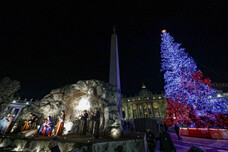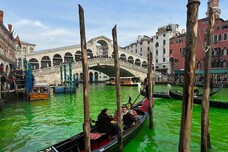The iconic Bay of Naples island of
Capri is on display in a new, monumental exhibition that the Met
in New York, in collaboration with Paris's Musée d'Orsay, is
dedicating until August 3 to American artist John Singer
Sargent, which includes the infamous Madame X that scandalized
the public and critics at the Paris Salon of 1884, inducing the
painter to move to London where he nurtured his fame with more
portraits of transatlantic high society.
In an effort to illustrate the painter's formative path, a
gallery takes the visitor to the famed Faraglioni island, a
beloved destination for artists throughout the 19th century, and
where the painter, who had already been there as a child,
returned in his early twenties to paint pictures that have been
mostly unknown because they were locked away in private
collections or small museums.
Capri provided the ideal backdrop to recreate an image of rural
life that would appeal to contemporary fantasies of a nature
uncontaminated by industrial capitalism, the curators explain.
Playing on the stereotype that the inhabitants were descendants
of the ancient Greeks and Romans, Sargent adopted the young
Rosina Ferrara as a model and muse and immortalized her in a
dozen paintings such as Dans les Oliviers a Capri shown in 1979
at the Salon, in which the girl is intertwined with an ancient
olive tree, while in another, on loan from the Crystal Bridge
Museum in Bentonville, Arkansas, she dances the tarantella on a
roof.
Sargent had asked his friend Frank Hyde to find him a local girl
"of a certain type" and he was enchanted by Rosina because of
her Mediterranean features "which were considered nonwhite at
the time."
Capri was not the only Italian place Sargent loved: Venice was
his true passion and on display, from the Dixon Gallery in
Memphis, is a portrait of the diplomat and aspiring artist Ramon
Subercaseaux in a gondola created in 1880 in which, according to
the friend's son, he was simultaneously painting a now-lost
watercolor portrait of Sargent.
The fulcrum of the exhibition, however, is the years in Paris,
where Sargent, an 18-year-old prodigy, arrived in 1874
disappointed by the teachings of the Academy of Fine Arts in
Florence, the city where he was born to globetrotting American
parents.
"Paris, at the time, was the epicenter not only of artistic
production and taste, but also of cultural exchange, and Sargent
was at the center of it.
"This exhibition celebrates Sargent's Parisian period and how he
used Paris as a base to travel throughout Europe, absorbing
influences and documenting his artistic journey," explained Met
Director Max Hollein at the ribbon-cutting ceremony for the
press, who said it was significant that the exhibition concludes
with one of the Met's masterpieces, the iconic Madame X
(Virginie Amélie Avegno Gautre): "A world-famous work that
marked the end of Sargent's Parisian phase — a period of
success, scandal, and complexity, before he moved to London."
ALL RIGHTS RESERVED © Copyright ANSA











